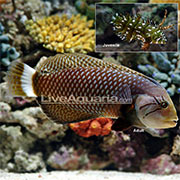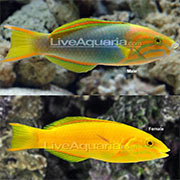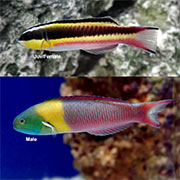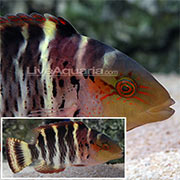|
Diversity among the family Labridae provides a plethora of options for the fish-only aquarium whether you're an "average" marine aquarist or a collector of unique and oddball wrasse.
Fish-Only Wrasses for the Aquarium
Many of the fish-only, non-reef safe wrasses grow large enough that they can be housed with more formidable tank-mates like Triggerfish, Groupers, Puffers, and Angelfish. Size is relevant so wrasses need to be appropriately matched, size wise, to their tank-mates.
For example, the Dragon Wrasse (Novaculichthys taeniourus) can grow upwards of 12" so larger mature specimens are great candidates for fish-only aquariums with robust tank-mates. However, juvenile Dragon Wrasses would not fare well with larger Triggerfish or Groupers since juvenile Dragon Wrasses are more passive and undersized, potentially becoming a meal for the Triggerfish or Grouper. When properly housed with appropriately sized tank mates, the addition of a Dragon Wrasse to your fish-only aquarium will certainly pique your interest when it displays its hunting techniques by literally "leaving no stone unturned", picking up and moving coral rubble or larger pieces of substrate in search of snails, crustaceans, worms or other invertebrates.
Banana Wrasse and Other Members of the Genus Thalassoma
Another iconic wrasse for the fish-only aquarium sure to add a splash of dayglow yellow, chartreuse, or even lime green color is the Banana Wrasse (Thalassoma lutescens). Adult female Banana Wrasse demonstrates the aforementioned yellow coloration while mature male Banana Wrasse boasts any combination of said palette. Both male and female will exhibit complementary bright orange markings on their head, face and fins. Banana Wrasse can grow to approximately 12" when fully mature.
Coming in slightly smaller at around 10" when grown is the Lyretail Wrasse (Thalassoma lunare) aka the Lunare Wrasse. It is aptly named due to the yellow crescent moon pattern that forms in the caudal, (tail) fin as the wrasse grows and matures. The overall body color of the Lyretail Wrasse can range from a deep teal to dark emerald green with accents varying from orange to magenta with blue on the face and fins.
Smaller yet, is the Paddlefin Wrasse (Thalassoma lucasanum) holding its own at an adult size of 7". The Paddlefin Wrasse is also known as the Rainbow Wrasse since mature males sport many colors with their heads being a bluish-green, shoulder section yellow and the latter three quarters of the body sporting a variation of rose to red coloration. Female Paddlefin Wrasses will retain a version of their juvenile color, becoming more intense with horizontal rows of colors including black, yellow and red.
When considering any member of the genus Thalassoma, it is important to know their personality can be as bold as their coloration. It is recommended to introduce Thalassoma Wrasses after most of the other aquarium inhabitants are established in the fish-only aquarium since these wrasse can be overly boisterous and even bully new tank mates.
Large Wrasses of the Genus Cheilinus
If you are a marine aquarist seeking a larger wrasse for a fish-only aquarium of 200 gallons in size or larger, then perhaps the Red Breast Wrasse (Cheilinus fasciatus) will suit your fancy. Unlike Thalasoma Wrasses, most members of the genus Cheilinus are peaceful for their size. However, they will eat smaller fish and any ornamental crustaceans.
The Red Breast Wrasse is also referred to as the Red Breasted Maori Wrasse. It not only stands out because of its prominent size and stature but also for its eye-catching coloration and patterning with vertical stripes alternating in colors of reddish-brown to a light creamy yellow-orange color. The eye of the Red Breast Wrasse commands your attention due to its red and black bullseye appearance. The alluring red-orange color continues onto the head of the wrasse as partial radial striations around its eye.
Not to be outdone, its cousin, the Broomtail Wrasse (Cheilinus lunulatus), is a magnificent and mythical looking wrasse. As its name implies, the Broomtail Wrasse sports a tail fin with extended caudal rays which imparts a fringed or broom-like appearance. Depending on the age of the wrasse, Broomtails can display a myriad of colors. A Broomtails head can be bright green with colorful spots ranging from yellow to purple depending on the wrasses' age and locale. Pectoral fins can be bright yellow to vibrant orange. The wrasses' mid-section can be light yellow to grey while the latter section can have darker vertical stripes. In more mature specimens, this section can also be deep dark blue in coloration.
This characteristic is not unique to the Broomtail Wrasse as age plays a contributing factor in influencing the color and pattern of many wrasses as they transition through various phases and stages throughout their lifetime.
Orange is the New Wrasse
One of the favorites among larger, fish-only aquarium wrasse is the Harlequin Tusk Wrasse (Choerodon fasciatus). With its bold orange vertical stripes outlined in electric blue coloration, yellow pectoral fins, always-observant orange eyes, and blue fangs the Harlequin Tusk Wrasse is a true spectacle. Its visible blue teeth are used for capturing and crushing crustaceans. The wrasses' teeth also allow it to hold the prey firmly between its jaws should the wrasse need to bash its prey against a rock or coral to break up its meal. The Harlequin Tusk Wrasse can be found in the waters from Indonesia to Australia. Interestingly, the Australian variety of Harlequin Tusk appears to have slightly brighter coloration than its Indonesian counterparts. As with other species of wrasse, region and locale can influence color variation within the species. You can expect a Harlequin Tusk Wrasse to grow to an approximate length of 10" in a properly-sized aquarium under optimal conditions.
Bird is the Word
The Labridae family keeps pushing the envelope in regard to variation in shape and color as exemplified by the fascinating Bird Wrasse (Gomphosus varius). The Bird Wrasse will captivate you with its unique shape, long beak-like snout, and penguin-like swimming style. The avian similarities are further reinforced by its large pectoral fins and penguin-like body shape. Mature Male Bird Wrasses develop a gorgeous teal coloration while female Bird Wrasses have dark reddish-brown spots and markings over a cream color body that transitions to black on the back half of the fish. Bird Wrasses are very active swimmers and require ample swimming room. In other words, a larger aquarium is a must.
Wrasse Requirements
With the exception of the Paddlefin Wrasse, all Fish-Only wrasses featured in this article should be housed in an aquarium of at least 6 feet in length. Wrasses are active open water swimmers that should be allowed ample space to swim. Feeding requirements for all the highlighted wrasses are similar, as most will fare well on a varied diet of frozen/thawed items such as enriched brine shrimp, mysis shrimp, krill, and quality marine pellet foods. Clam on the half-shell, chopped squid and prepared marine predator diets will satiate the appetites of larger wrasses. Different species of wrasses display similar behaviors like hunting and foraging using their keen eyesight in tandem with their intelligence to pick up and move small rocks or rubble with their mouths in order to find prey.
Many wrasse species burrow in the substrate during the night hours so a deep layer of substrate in the aquarium will be appreciated. Certain wrasses can even produce a mucous sack or "cocoon" around them to help camouflage their scent from predators and ward off parasites. With such an array of wrasses to choose from coupled with their interesting behaviors and compatibility with other wrasse species that can be housed together in the same aquarium, it is easy to see how wrasses have gained in popularity!

Dragon Wrasse |

Banana Wrasse |

Paddlefin Wrasse |

Red Breast Wrasse |
|